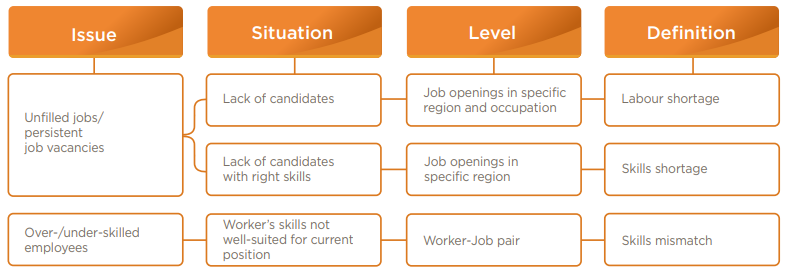Table of Contents
Key Findings
- Labour shortages, skills shortages, and skills mismatches negatively impact individual well-being and dampen growth, productivity, and competitiveness at both the firm- and economy-wide level.
- These three concepts are often used interchangeably, creating confusion and uncertainty, potentially leading to inappropriate or ineffective solutions. As such, the following definitions are recommended:
- Labour shortages refer to a lack of candidates for a specific job in a specific labour market.
- Skills shortages refer to a lack of candidates with the skills required by particular employers.
- Skills mismatches refer to situations in which an employee’s current skills are not well suited to their current job.
Introduction
In our first LMI Insight, "Taking Stock of Past Labour Market Information Assessments," we noted that one of the four main gaps in labour market information (LMI) is in the measurement and interpretation of labour shortages, skills shortages, and skills mismatches. This edition of LMI Insights adds clarity by offering specific definitions for these three closely related workforce issues.
Labour shortages, skills shortages, and skills mismatches have been brought to the forefront of policy discussions in recent years.1 These three concepts are of interest to a diverse set of stakeholders, from employers and policy makers to individuals, researchers, and the media.2 The lack of a common framework for defining and understanding these concepts complicates the subject.
The Issues
Two issues of growing debate in Canadian labour markets are 1) unfilled jobs/persistent job vacancies and 2) over-/under-skilled employees.3 With respect to the first, many employers in Canada report difficulty in finding workers to fill jobs, which can result in labour cost pressures, employee turnover, and missed productivity or revenue gains.4 When workers do not have the qualifications or skills needed by employers, they may stay unemployed longer, forgoing potential income, which reduces individual and societal well-being. Second, when a job is filled, it may be that the worker possesses fewer, more, or even different skills than those needed to be successful in their role. This issue can lead to a number of challenges for the firm (e.g., lower productivity) and the individual (e.g., job dissatisfaction).5
Indeed, persistent job vacancies have been noted as serious hindrances in certain regions and sectors in Canada with calls for various policy responses. For example, some industry leaders have called for renewed efforts to increase the supply of labour through immigration and by incentivizing labour market participation, notably of under-represented groups.6 Others argue that increasing labour market participation misses the point - that the labour force needs to be upskilled7 - and have called for renewed efforts to place increased emphasis on developing workers’ skills, notably "soft skills."8
The policy response should depend on the underlying cause of the issue. However, there is considerable confusion regarding the terminology used to describe and understand these issues. The inability to fill jobs, for example, has been referred to as a "labour shortage," a "skills shortage," and a "skills mismatch." Similarly, the terms "skills shortage" and "skills mismatch" have both been used synonymously with over- and under-skilled workers.9 The following section aims to clarify these three terms to ensure the debate, and resultant policy responses, are informed by accurate labour market information and insights.
Box 1: Measuring Up: Understanding the Differences between Qualifications and Skills
Qualifications, formal and informal: In research, "qualifications" most commonly refers to documentation, such as degrees, certificates, diplomas, or other such credentials, that signify the successful completion of an educational program or course. This definition, however, excludes informal qualifications that employers may also require of jobseekers, such as years of experience.
Skills: Skills are not easy to measure, nor are they clearly defined. Until recently, data collection did not directly measure skills. And while there has been progress, such as the OECD’s (2016) Survey of Adult Skills, the skills assessed are basic ones.10 For our purposes, we refer readers to the International Labour Organization’s definition that skills are "the ability to carry out the tasks and duties of a given job" (ILO, 2004). The forthcoming Future Skills Centre will play an important role in advancing the identification and measurement of skills in Canada (see Box 3 in LMIC, 2018).
Qualifications as a proxy for skills: The inherent challenges in measuring skills means researchers typically use qualifications as a proxy for skills. This method is so common that skills and qualifications are used synonymously in certain cases. Canadian labour market data is collected on the basis of the National Occupational Classification (NOC) system, which uses "skill level" and "skill type"11 as classification criteria (Statistics Canada, 2018). Yet, NOC "skill level" refers to the typical formal education needed for a given occupation (i.e., degree or certification) rather than skills as defined here.
Making Sense of the Jargon
To add clarity to these terms, it is first important to make a distinction between qualifications and skills since the two are often used interchangeably (Box 1).
Keeping in mind the distinctions between qualifications and skills, as well as the challenges to the empirical measurement of skills, this section lays out a simple taxonomy of labour shortages, skills shortages, and skills mismatches (see Figure 1).
Figure 1: Key concepts and definitions

Labour shortages: Labour shortages occur when there is a lack of candidates for a particular job. An insufficient supply of job candidates is typically thought of as a lack of any applicants. More common is the lack of applicants possessing the minimum qualifications to be considered viable, including whether the person is eligible to work in the region and in the occupation. Consider the case of Northern Ontario, which has faced a labour shortage of dental hygienists in recent years.12 If, at one point in time, there are ten hygienist openings but only six applicants who are registered with the College of Dental Hygienists of Ontario (CDHO), then there is a labour shortage of dental hygienists in Northern Ontario.
The core aspect of a labour shortage is that it is always specific to a labour market delimited by an occupational category13 and a geographical region14 (see Box 2). Yet, a viable applicant might not be suitable for the position, which brings us to the issue of skills shortages.
Skills Shortages: A skills shortage occurs when there is a sufficient number of candidates (i.e., applicants with the minimum qualifications to be considered viable), but they are not hired because the employer deems them to not have the skills required, such as critical thinking, occupation specific technical skills or writing. In other words, there are viable applicants, but their specific skills set does not match the needs of the employer for that job. Using the example again of dental hygienists, in this case, when there are ten viable dental hygienist applicants for ten dental hygienist openings but four of them lack the requisite skills - such as the ability to deal effectively with patients or good attention to detail - then there is a skills shortage.
Like labour shortages, skills shortages can be defined with respect to a particular region and occupation. However, a skills shortage may be much broader, as one may speak of a general lack of attention to detail across occupations.
Skills Mismatches: A skills mismatch refers to the situation in which an employee’s current skills do not match those needed to perform their current job. In all cases, a skills mismatch is identified at the level of a worker-job pair. Comparing an employed person’s skills and the degree to which these align with the needs of the job determines a skills match.15 Since the requirements of any job may change over time, an individual may be well-matched at some point, only to become mismatched if the employer’s requirements and the employee’s skills diverge. So, a viable dental hygienist with the requisite skills is hired, but the job evolves in a manner that now requires a new skill set, not currently possessed by the employee. In this case, their current skill set would not align with that demanded by their job, exemplifying a skills mismatch.
It is important to note that there is always some level of individual worker-job mismatch. In this respect, skills mismatches are unavoidable, as they are the consequence of adverse selection under asymmetric information (see Box 3).
Box 2: A Long-Distance Relationship
A key to understanding this discussion is that labour markets are geographically delimited. This is important because it further divides how information is collected, analyzed, and interpreted. In some cases, data are reported at the pan-Canadian level. Thus, it is common to see reports of the average Canadian wage growth for engineers, rather than information about engineers’ wages at, for instance, the provincial or municipal level. In a country as large and diverse as Canada, highly aggregated data can be misleading when they mask differing labour market trends across different regions.
Part of the difficulty is in defining who is and who is not in a geographically defined labour market. People within commuting range of Halifax are likely in that labour market, but so could be job seekers in Vancouver who are willing to relocate. The solution here is to consider only those individuals applying for job openings as part of the labour market in which a skills shortage or labour shortage exists. Clearly, this approach becomes more difficult when considering business and policy solutions since labour markets are dynamic. For example, a large increase in wages in a region may increase the pool of applicants in that labour market. Further discussion of these conceptual issues is beyond the scope of this edition of LMI Insights but generally, exact boundaries of a labour market can shift as job conditions change.
The Way Forward
To avoid drawing incorrect conclusions (and implementing inappropriate or ineffective policy interventions), it is essential that all parties better understand the terms employed and recognize the distinctions between them. To that end, we recommend the following:
- Clearly distinguish among the three categories discussed using the following definitions:
- Labour shortages refer to a lack of candidates for a specific job in a specific labour market.
- Skills shortages refer to a lack of candidates with the skills requested by particular employers.
- Skills mismatches refer to situations in which an employee’s current skills are not well suited to their current job.
- Address specific labour market geographies. Local shortages and mismatches can be missed by national- or provincial-level indicators. Detailed and timely labour market information at a local level is essential. This will improve labour market participants’ ability to make good decisions regarding business operations, regulatory changes, and educational program choices, to name only a few uses.
- Care should be taken when using qualifications as a proxy for skills. Although the mapping of skills to occupations, like with the National Occupational Classification (NOC) system, and the measurement of basic skills, such as is done with the Survey of Adult Skills, provide some quantifications of skills supplied, these tools are limited in scope. Indeed, it is broadly recognized that more must be done to advance realistic methods for measuring and developing workers’ skills. In Canada, the Future Skills initiative that will test, and measure new approaches to skills assessment and development is an important step forward (see Box 3 in LMIC, 2018).
Box 3: Asymmetric Information
Asymmetric information describes a situation in which transacting parties have varying and incomplete amounts of information. In the case of recruitment, the firm knows the nature of the work and position (work conditions, culture, etc.); the jobseeker can only infer them. Similarly, the jobseeker knows his or her work behaviours (hardworking, fast-learning, etc.); and the firm can only make educated guesses based on the resume and interview. The more incomplete the parties’ information, the more likely there is to be a mismatch, including with respect to the skills required versus those supplied. Evidently, with respect to recruitment, asymmetric information is closely linked with the difficulty of identifying and measuring candidates’ skills.
Acknowledgements
This LMI Insight was prepared by Anthony Mantione of LMIC. We would like to thank LMIC’s partners in federal, provincial and territorial jurisdictions as well as in our National Stakeholder Advisory Panel and Labour Market Information Experts Panel for their comments and suggestions in preparing this LMI Insight. In particular, the team would like to acknowledge the valuable feedback and input of Sandip Basi, David Chaundy, Michel Cournoyer, Alexandra Cutean, Jeff Donnelly, Ana Ferrer, Debra Hauer, Jeremy Higgs, Carol Howes, Karen Charnow Lior, Ellen MacEachen, Patricia Noble, Catherine Ouellet, Ernie Stokes, and David Ticoll. We would also like to thank Stijn Broecke and Glenda Quintini (OECD), Santo Milasi (ILO), and Arthur Sweetman (McMaster University) for their comments and feedback.
For more information about this report, please contact research@lmic-cimt.ca.
References
Advisory Council on Economic Growth. (2016). Attracting the talent Canada needs through immigration. Retrieved from https://www.budget.gc.ca/aceg-ccce/pdf/immigration-eng.pdf
Advisory Council on Economic Growth. (2017). Tapping economic potential through broader workforce participation. Retrieved from https://www.budget.gc.ca/aceg-ccce/pdf/workforce-marche-travail-eng.pdf
Atlantic Provinces Economic Council. (2017). Immigration on the rise in Atlantic Canada. Retrieved from https://www.apec-econ.ca/publications/view/?do-load=1&publication.id=328&site.page.id=51001
Canadian Agricultural Human Resource Council (2016). Agricultural workforce management report: Recruitment & wages. Retrieved from https://cahrc-ccrha.ca/sites/default/files/Ag%20Workforce%20Management%20-%20Recruitment%20Wages-Eng.pdf
The Canadian Dental Hygienists Association (2012, June 1). Addressing dental hygiene labour shortages in rural and remote areas. Retrieved from https://www.cdha.ca/cdha/The_Profession/Policy_Advocacy/Tagged_Content/Addressing_Dental_Hygiene_Labour_Shortages_in_Rural_and_Remote_Areas.aspx
Carey, D. (2014). Overcoming skills shortages in Canada. OECD Economics Department Working Paper, no. 1143.
Paris: OECD Publishing.
Cross, P. (2014a). Do labour shortages exist in Canada? Reconciling the views of employers and economists. Fraser Institute. Retrieved from http://books.scholarsportal.info/viewdoc.html?id=678202
Cross, P. (2014b, July 30). Do labour shortages really exist in Canada? Financial Post. Retrieved from https://business.financialpost.com/opinion/do-labour-shortages-really-exist-in-canada
Dangerfield, K. (2017, December 12). There are 361K job vacancies in Canada-here’s where workers are needed. Global NEWS. Retrieved from https://globalnews.ca/news/3911539/job-vacancy-canada-workers-needed/
Heckman, J. J., & Kautz, T. D. (2012). Hard evidence on soft skills. NBER Working Paper Series. Retrieved from http://www.nber.org/papers/w18121.pdf
International Labour Organization. (2004). ISCO international standard classification of occupations conceptual framework. Retrieved from https://www.ilo.org/public/english/bureau/stat/isco/isco88/publ2.htm
Komarnicki, E. (Ed.). (2013). Labour and skill shortages in Canada: Addressing current and future challenges. The Standing Committee on Human Resources, Skills, Social Development, and the Status of Persons with Disabilities. Retrieved from http://books.scholarsportal.info/viewdoc.html?id=560695
LMIC. (2018, 29 August). Taking stock of past labour market information assessments. LMI Insight, vol. 1.http://blog.lmic-cimt.ca/wp-content/uploads/2018/08/LMIC-CIMT-LMI-Insights-No.1.pdf
LMIC. (2018, 24 September). The future of work in Canada: Bridging the gap. LMI Insight, vol. 2. https://lmic-cimt.ca/wp-content/uploads/2018/09/LMI-Insights-Issue-2-EN.pdf
OECD. (2016). Skills matter: Further results from the survey of adult skills. OECD Skills Studies. Paris: OECD Publishing. doi:10.1787/9789264258051-en
Oral Health (2015, May 1). The perceived issue of oversupply of dentists. Retrieved from https://www.oralhealthgroup.com/features/the-perceived-issue-oversupply-dentists/
Sattinger, M. (2012). Assignment models and quantitative mismatches. University of Albany. Retrieved from https://www.albany.edu/economics/research/seminar/files/Michael%20Sattinger.pdf
Statistics Canada (2018, June 17). Introduction to the national occupational classification (NOC) 2016 version 1.1. Retrieved from https://www.statcan.gc.ca/eng/subjects/standard/noc/2016/introductionV1.1
Endnotes
- Most prominently, these issues are often raised in the context of the future of work. For more information on the future of work as it relates to Canada, please see LMI Insight No. 2, "The Future of Work in Canada: Bridging theGap" and LMIC’s Annotated Bibliography on the Future of Work.
- See for instance, the Association of Canadian Community Colleges’ National skills summit summary report; the report of the Standing Committee on Human Resources, Skills, Social Development, and the Status of Persons with Disabilities; Global News and Financial Post articles: There are 361K job vacancies in Canada-here’s where workers are needed and Do labour shortages really exist in Canada?
- Of course, another major issue confronting many workers in certain areas of the country - not explored in this edition of Insight - is the lack of job opportunities.
- At the macroeconomic level, unfilled jobs can act as drag on economic growth and dampen productivity and competitiveness.
- See, for example, Sattinger (2012).
- See, for example, Canadian Agricultural Human Resource Council (2016); Atlantic Provinces Economic Council, (2017); Advisory Council on Economic Growth (2016, 2017); Komarnicki (2013).
- See, for example, Cross (2014a, 2014b); Carey (2014).
- "Soft skills" refer to character and socio-emotional abilities, such as clear communication, emotional intelligence, and adaptability, to name a few (Heckman & Kautz, 2012).
- "Skills gap" and "skills imbalances" are two additional terms that are used to describe skills-related labour market issues. Since they are often used as umbrella terms to describe the particular situations herein laid out, in an effort to be precise and consistent, we recommend using the situation-specific terms "labour shortages," "skills shortages," and "skills mismatches." If the definition of "skills gap", "skills mismatches" or any other term differs from those proposed here, one should be precise in how they differ (see also endnote 15).
- "Basic skills" are those skills generally acquired through the K-12 education system, including fundamental literacy, numeracy, and problem-solving skills.
- "Skill type" refers to the type of work performed. It is used to identify ten broad occupational categories, such as sales and service occupations (skill type 6) and health occupations (skill type 3).
- For evidence of maldistribution of dental hygienists in rural/remote communities in northern Ontario see https://www.cdha.ca/cdha/The_Profession/Policy_Advocacy/Tagged_Content/Addressing_Dental_Hygiene_Labour_Shortages_in_Rural_and_Remote_Areas.aspx and https://www.oralhealthgroup.com/features/the-perceived-issueoversupply-dentists/
- "An occupation is defined as a collection of jobs, sufficiently similar in work performed to be grouped under a common label for classification purposes" (Statistics Canada, 2018).
- The geographical region varies with perspective. In some cases, job markets are global; in others, one can speak of the national labour market for engineers, for example, in which case Canada is the region. Or, one may speak of "commuting zones" around a particular city.
- The Network for international policies and cooperation in education and training (NORRAG) refers to skills mismatches, as herein defined, by the term "skills gaps." Such use, however, is not consistent in either the media or academia, where "skills gap" has either been used synonymously with skills shortages or specifically to mean an undersupply of basic skills. Thus, we refrain from using this terminology.

